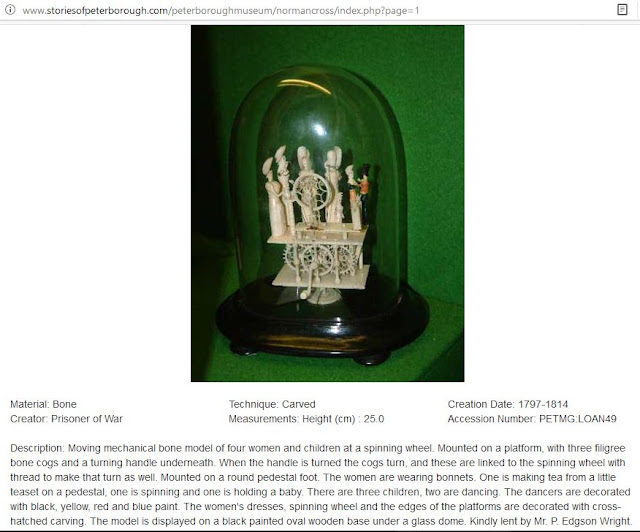Origine des plus belles "spinning jennies" (automates), les prisonniers français en Angleterre , ou les artisans de Méru dans l'Oise avec les ivoiriers de Dieppe, avant , après 1815 ?
Exemples et contre-exemples
When, where and Who really made the most beautiful spinning jennies, bone crank automata, napoleonic PoW in England, or craftsmen of Méru , Oise France with other craftsmen of Dieppe, after or before 1815?
SOURCE 1/2:
source https://www.kohn.paris/catalogue/09-mars-2016/
résultat vente : 3000€
(artiste et date inconnus)
source: https://www.kohn.paris/wp-content/uploads/2016/03/Marc-Arthur_Kohn_catalogue_09-03-2016.pdf,,,,,,,,,,,,,,,,,,,,,,,,,,,,,,,,,,,,,,,,,,,,,,,,,,,,,,,,,,,,,,,
contre exemple 1/2
Spinning jenny achetée à Norman Cross par Mr. Wright at Norman Cross. avant 1815.
"The group of figures on a platform (Plate XVI, Fig. 1), is one of many such mechanical toys or ornaments p. 131known to the author. This is beautifully preserved, having been kept in the box in which it was purchased for many years. When the lower wheel below the platform is turned, by an arrangement of the threads passing over the wheels, the various figures move, the lady in the centre turns the winding-wheel, the child moves forward, the soldier and the lady waltz, the mother tosses her baby, turning her head to look at it, while the lady on the left prepares the tea. The owner of this ornament is the grandson of its purchaser." Thomas James Walker.
Thomas James Walker The depot for POW at Norman Cross....
source:https://www.gutenberg.org/files/43487/43487-h/43487-h.htm
page 132.
pict: Peterborough Museum .moving mechanical model
contre exemple 2/2
"made by French prisoners of war in Carnarvon Gaol and given to the Lord Lieutenant of Carnarvon Castle for his kindness during their captivity" (Welsh: Castell Caernarfon )
Paul Chamberlain, author of 'Hell Upon Water: Prisoners of War in Britain 1793-1815' said:
From 1793 until 1814, over 200,000 French and French allies were held as PoWs, and whilst it's impossible to put a definite figure on it, several thousand of them would have been held in Wales.
!!!!!!!!!!!!!!!!!!!!!!!!!!!!!!!!!!!!!!!!!!!!!!!!!!!!!!!!!!!!!!!!!!!
SOURCE 2/2:
http://www.gazette-drouot.com/static/magazine_ventes_aux_encheres/cotes_et_tendances/ivoire_dieppe.html
"L’ivoire est d’abord envoyé dans l’Oise, dans le canton de Méru, pour être débité, puis retourné à Dieppe pour y être sculpté, et enfin déposé à Paris..."
Par Anne Doridou_Heim-La Gazette Drouot N°10 du 12 mars 2010
Musée de Méru
source: affiche musée de Méru
Ivoiriers de Dieppe
Jean Colette et aujourd'hui sa fille Annick Colettevoir aussi Francis Migean
Pierre Meyer
Musée des ivoires d'Yvetot
 |
| photo:https://www.amysduvieuxdieppe.com/ivoiriers/ |
Exemple:
Le bon Henry [anciennement le Ville de Dieppe]maquette attribuée à
Dieppe, 1818/04/05 ; Dieppe (?), 1882/04/26 ; nationalité : Française
|

source
http://www2.culture.gouv.fr/public/mistral/joconde_frautres sources
http://www.storiesofpeterborough.com/peterboroughmuseum/normancross/index.php?page=0
Moving mechanical bone models.
Norman Cross Collection
The Prison at Norman Cross, near Peterborough, was built to hold French and Dutch prisoners captured during the Napoleonic Wars between 1797 and 1815.Considered both the largest and finest collection of such items in the world, the museum displays objects of carved bone and ivory, including model ships, guillotines, needlework boxes, playing cards and articles of straw marquetry.
72. Model Cockerel (Life-Size)
Category: ModelTechnique: Carved
Material: Bone
Accession Number: PETMG:1996.006
pict: Peterborough Museum .moving mechanical model
§§§§§§§§§§§§§§§§§§§§§§§§§§§§§§§§§§§§§§§§§§§§§§§§§§§§§§§§§§§§§§§§




























